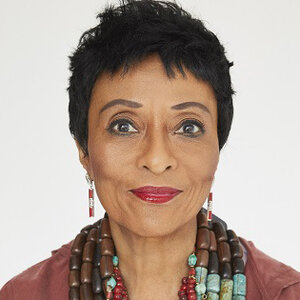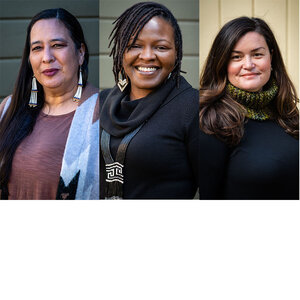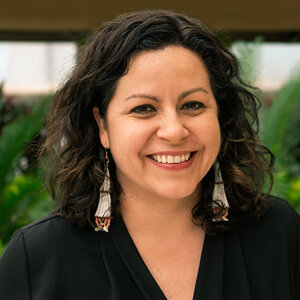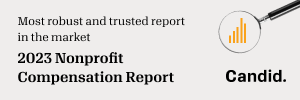Erik R. Stegman, CEO, Native Americans in Philanthropy: An ecosystem approach to philanthropy
January 4, 2023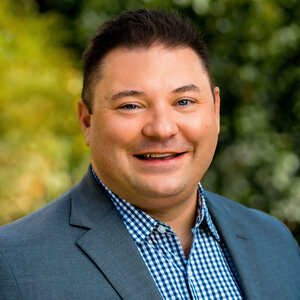
Erik R. Stegman (Carry the Kettle First Nation Nakoda) has served as CEO of Native Americans in Philanthropy (NAP) since February 2020. He previously served as executive director of the Aspen Institute’s Center for Native American Youth, director of field outreach and advocacy at the Center for American Progress, and counsel for the U.S. Senate Committee on Indian Affairs.
In early December, NAP, the White House, and the Department of the Interiorlaunched the Office of Strategic Partnerships (OSP), a public-private partnership aimed at leveraging collaborations between the federal government, philanthropy, and Tribal communities. According to NAP, while Tribes control approximately 5 percent of the Unites States’ landmass, the 95 million acres of land managed by 574 federally recognized Tribal nations encompass some of the continent’s most critically important wildlife habitat, resilient landscapes, and irreplaceable cultural assets.
PND asked Stegman about the collaborations under way with OSP, the factors behind the underinvestment in Native-led initiatives in the U.S., the recently launched Tribal Nations Conservation Pledge & Funding Collaborative, and the immediate and long-term impact Native leaders are making in the public and philanthropic sectors.
Philanthropy News Digest: The newly created Office of Strategic Partnerships (OSP) plans to support Tribally led projects with a focus on the areas of conservation, education, and economic development initiatives in Native communities. What form will that “support” take? Can you give an example of the types of collaborations you expect to see in each of the three areas?
Erik R. Stegman: First, now with this transformational set of potential investments that the federal government is making across the board—from the transportation and infrastructure bill to the Inflation Reduction Act, and then the regular spending bills—we felt the need for an office that’s focused on Indian Country to help us coordinate and prioritize across agencies: what those funding streams look like and where we can think about the highest-impact opportunities. One really important part of the office is to have a bird’s-eye view and be a coordinator across the different programs and agencies that work directly with Tribes. That’s one of the reasons we felt it was important that it was housed at the Bureau of Indian Affairs.
Secondly, to drill down on those three areas that you mentioned: In conservation, we’re already well under way with a lot of work in that space. We have a new Tribal Nations Conservation Pledge & Funding Collaborative partnership with the Biodiversity Funders Group (BFG). With all the funders in that group, we’ve launched a pooled fund that’s specifically focused on supporting federal leverage opportunities when it comes to Tribally led conservation. The pledge component will be doing some of that work but also investing in the capacity of nonprofits that are supporting Tribes and accessing those dollars.
Just recently we finalized a partnership with the National Fish and Wildlife Foundation (NFWF) to support Tribes accessing the America the Beautiful Challenge (ATBC), which is a really extraordinary new public-private partnership between multiple agencies and philanthropy that was able to streamline $370 million in infrastructure money from the departments of Defense, Agriculture, and Interior and then match it with philanthropy for a $1 billion investment in conservation projects across the country. NFWF, which is administering that program, and we are guaranteeing the non-federal match through our pooled fund, and we were able to help secure a full third of the first funding round for Tribal projects. So in the conservation space, we’ve already been doing the work, and we have two more funding rounds coming up under that public-private partnership. The new office is going to help us deepen our relationships across many climate and conservation programs, building off of what we’ve learned—working with some of the other agency partners to think about what other funding pools we could be supporting, bringing philanthropy to the table.
As for economic development, there’s so much potential opportunity in that space, but what we’re trying to do is to create a concrete strategy in the short and medium term to help Tribes think about what kinds of federal resources they’re going to want to try to access for economic and community development. Especially with the Inflation Reduction Act, there are a lot of different ways that money is going to flow, and we need someone inside the federal government helping us understand that, collecting that data and information from different offices, and helping us think about how that fits into Tribal economic development.
And in education, we are going to be very specifically focused on figuring out how to support existing education programs. There are a number of barriers to some of that funding at the federal level that could potentially be worked out and streamlined through processes similar to what we’ve done with NFWF. There are also a lot of opportunities for education philanthropy to partner with us on specific Tribal priorities, particularly with language and education programming. It’s one of the biggest priorities for Tribal leaders and the Biden administration and secretary of the interior Deb Haaland, so they’ve prioritized a lot of funding going directly into new language- and culture-based education funding. There are a lot of opportunities for philanthropy to support that work and to really think about how they align their own investments with where some of that federal dollars can go.
Those are the three areas that we’re planning to work on with OSP, while also starting to chart out a more long-term strategy for other areas.
PND: What impact has the appointment of Deb Haaland as secretary of the interior had in boosting the visibility of Native-focused and -led nonprofits and the work they do?
ERS: It’s historic and unprecedented, and I think that’s for a couple of reasons. One, it has elevated issues that Tribes and Tribal communities have been advocating for through their nation-to-nation relationship for generations. But to have one of our own people at the helm of the most important agency for Tribes, in that nation-to-nation relationship, is a messaging opportunity we haven’t had. I just attended the White House Tribal Nations Summit; the first lady held the first official White House Native American Heritage Month reception; and to see the impact on our own people and the response to people like Secretary Haaland—among our youth leaders, our elders, all our professionals, and our agency partners who are Native…there is pride in having that kind of voice inside the federal government that’s hard to explain. I think the combination of her championing our issues as a Native person externally to non-Native people in the United States, while also being an inspiration to our own people, has a lot of power behind it. And I think we’re starting to see the results of that in these transformational investments and some of the biggest policy issues that they’re finally tackling.
PND: You’ve said that many global philanthropic investments in Indigenous movements and Native-led initiatives neglect U.S.-based Tribes, despite evidence that Tribes are the best stewards of their lands, waterways, and lifeways. What are the factors behind the underinvestment in U.S.-based tribes? And do you see that changing now, with increased international focus on Indigenous-led climate mitigation efforts?
ERS: This is specific to climate and conservation. Sometimes I feel like I understand it and other times I don’t. Some of it has to do with the perspective of some climate and conservation funders in general, so depending on who you’re talking about, this is an issue that they’re already tackling. I think a number of those funders don’t pay enough attention domestically to what we could be doing here on climate and conservation. When it comes to Indigenous issues, the political dynamics of Indigenous land stewardship are very different across the world. In certain places where a lot of these funders are investing, they’re doing a lot of grassroots movement investment and other kinds of work to support our relatives in different countries who are working to try to control and steward their lands.
But here we have a very unique political and legal relationship with the U.S. government, and it’s mystified too many funders for too long. And rather than taking the time to learn how to engage with Tribes in the U.S., they’ve seen it as being too complicated and put their energy elsewhere. I think now we’re starting to see a real shift among a lot of these funders, in wanting to actually take the time to learn about how U.S. Tribes are working on climate conservation, but also what investments in Tribes could mean when it comes to some of the political and legal power that they’re trying to move forward when it comes to some of these huge initiatives like the 30x30 initiative, ATBC, and the recent announcements at the COP27 meeting.
[W]e’re starting to see a real shift among a lot of these funders, in wanting to actually take the time to learn about how U.S. Tribes are working on climate conservation....
My conversations with a lot of those funders about why they haven’t focused enough on Indigenous efforts in the U.S. is about how it’s too complicated—what they see as the messy complications of 574 federally recognized Tribes, the role the federal government is supposed to play, so maybe philanthropy doesn’t need to be as involved. I think what’s changed now is their understanding that those messy complications come with political power, because Tribes have been the stewards of these lands for a long time. Now we’re entering into these really innovative co-management agreements with the federal government, and funders are starting to realize that in some cases, Tribes actually have more resources like land managers and forest managers and employ more wildlife biologists than the states. They’re starting to realize that it’s important to better understand these complications because those complications come from the legal power we have at the table.
I’m really heartened by the shift we’re starting to see. Some of these partnerships like we have with BFG are where I’m seeing that shift happen—mainly because they’re taking the time to listen to our Tribal leaders and our experts about the great work they’re doing and seeing opportunities to invest in these big leverage opportunities now.
PND: As you mentioned earlier, NAP and BFG launched the Tribal Nations Conservation Pledge & Funding Collaborative in November—with seed funding of $1 million from the Christensen Fund—calling on the philanthropic sector to commit $100 million to projects led by Tribal nations. Grantmakers can pledge to allocate a specific amount or a percentage of annual programmatic spending to tribes, inter-Tribal organizations, and Tribal consortia and/or contribute to the fund directly. How would you describe the response to date?
ERS: Although we officially launched it in November, we’ve been working on this for almost a year now and we’ve had tremendous interest. I want to share my gratitude with our partners at BFG, because they really wanted to approach how to do this work differently—to not only think about how two philanthropy-serving organizations can come together to bring the depth of their funder networks to the table, but to really let a Native-led philanthropy advocacy group be in charge of this process. I think the most important point is funder education and relationship building, and we’ve brought on a lot of great funders who’ve been real strategic partners with us in designing this fund and pledge. We wanted this to be an opportunity for any conservation funder to be able to commit—whether they want to write a check to a pooled fund and just know that we would bring together Tribal leaders and partners to make sure that those funds are invested in the way the Tribes want them to, or whether they are able to pledge some of their own direct grantmaking according to criteria that our Tribal Leader Advisory Council and others are developing. And on top of that, we’ve launched a learning series that we co-host with BFG, and that’s been really powerful.
PND: Has there been more interest in giving directly to the pooled fund as opposed to pledging a certain percentage of their grantmaking dollars? Do you see a trend?
ERS: One is really supporting the other. The part that’s less developed at this point is the pledge. A number of funders wanted to invest right away in the pooled fund to catalyze this work and to give us what we needed to figure out what the timely opportunities are. We’ve raised a little more than $4.5 million in the pooled fund and were able to sign that MOU with NFWF very quickly. We were also able to provide technical assistance to our Tribal partners on the ground; it was a blended sort of capacity-building and funding opportunity that’s led to real results, and we’re now able, through that pooled fund, to commit for the next two funding rounds. But we’ll continue to raise money through that and the pledge to build on what we’ve learned. We have a better sense of where we can nimbly enter these partnerships can also support the pledge.
The biggest opportunity for the pledge is that in partnering with NFWF in the scoring and other work with these grant applications, we have this list of Tribes that have shared their vision and plans around what they want to do in conservation. And we’re able to identify those that need capacity-building support to help get them funded in the next round. Some of the funders in the pledge are really interested in direct investment in organizations supporting those Tribes. What we’re working on now is taking what we learned in this initial effort and thinking about a short-, medium-, and long-term plan for direct funding and capacity building. That’s what the funders involved in the pledge are excited about, because some of them are focused in very specific areas, such as marine work for the David & Lucile Packard Foundation, and we can help facilitate those relationships.
We were also able to provide technical assistance to our Tribal partners on the ground; it was a blended sort of capacity-building and funding opportunity that’s led to real results....
PND: One of ATBC’s priorities is “grant funding for restoration, conservation, and capacity building, and [the organization] seeks projects that incorporate Indigenous traditional knowledge in planning and implementation.” What would incorporating Indigenous traditional knowledge in planning and implementation look like in practice?
ERS: I think it means a lot of different things. One of the biggest shifts that the conservation funding world is starting to understand is the importance of traditional ecological knowledge. If you look at the combination of forest management and wildfire management in California, for instance, a lot of the most important fire and mitigation work is done by Tribes. Tribes have been managing those forests and preventing fires based on that traditional knowledge and understanding—their understanding of the land, the plants, and the species there—for a long time, and also using Western science to complement and support their approaches in that work.
I would also say that part of the important work based on traditional knowledge that’s been anathema to the sector for too long is the idea of ecosystem management. The conservation funding world is one of the most siloed I’ve seen, which is saying a lot about philanthropy. But you can’t have people funding conservation of rivers and marine areas and mountain areas all in siloes, because that’s not how nature operates, and it’s certainly not the way Tribes have understood how to manage those ecosystems for many, many generations. Indigenous scholars, wildlife biologists, forest managers, and fisheries managers have been partnering with nonprofits that are helping with dam removal and rivers, etc., but they’re also doing studies at the marine level on the coast and working on fisheries management up in the mountains. And all of this is based on traditional methods and ecosystem-focused work. But for too long, conservation funders have been investing in these extremely siloed efforts that don’t connect to one another.
The new National Bison Range, which is one of the new collaborative efforts with the federal government—with the Bureau of Land Management and the Department of the Interior and philanthropy and Tribes all working together to restore buffalo habitat—is based on things that we’ve been doing for a long time, but the science backs it up. I think there’s going to be a lot of exciting work happening; we’re going to be able to bring our own experts to the table, showcase the work they’re doing, and actually show funders how much impact there is when you let Native people really lead in this kind of environmental management work.
PND: The Green 2.0 NGO & Foundation Transparency Report Cardfound that only 2.2 percent of all full-time staff and 4.2 percent of heads of 64 environmental NGOs and just 0.5 percent of staff and none of the heads of 20 foundations surveyed identified as American Indian/Alaska Native. Given the essential role Native-led efforts play in conservation, what are the implications of this underrepresentation, and how can it be addressed?
ERS: One of the most important partners in our entire conservation collaborative is Carla Fredericks, who runs the Christensen Fund, which has been an important player in the space for a while, but to have a Native woman who is incredibly well respected in this area…. I would have never been able to move forward on this as quickly and effectively without a Native person with those resources. What’s been exciting about having someone at the head of a foundation is that they’re educating the field differently—because they have gravitas and influence in that position, but they’re also able to steer resources in a way that we know how to use them, and we’re already seeing the results. So just one person at one foundation in the field has already had a tremendous impact. Imagine what that could be if we had even more.
I do think a little bit of influence reverberates across the rest of the sector, too, because if I’ve learned anything, especially in the environmental spaces, it’s that this is a group of funders that’s extremely technically involved in the work. And sometimes that can be a good thing, but sometimes it can be a bad thing. Some of the staff at foundations who understand the policies and the science can be really helpful strategic experts, but if they aren’t Native and they don’t understand a Native perspective, they can do a lot of damage—and they have in the past. That’s why we’ve seen Tribes frustrated with some of these big NGOs saying that they’re partnering with Tribes but when you ask the Tribes, they’re like: “No, they really just brought us along with their own strategy, and we felt kind of left behind.” But we’re seeing some big changes; some of the big NGOs have multiple Native staff, not yet at the senior levels I’d like to see, but they’re starting to invest in more recruitment and in the right positions. So we’ve been having much more strategic conversations. And through this collaborative, we’re also supporting some of the peer-to-peer networks of Native people working in those NGOs.
When you think about passionate Native people working inside those big green nonprofits, when they have people like Carla and us behind them and the power of an entire funder network like BFG, that puts them in a very different power position than they were in before. They’re getting invited to our learning series; we’re helping draw out their expertise inside their own organization, but in front of a coalition of funders and other nonprofits. That’s where I see the shift happening, and I’m actually pretty hopeful. But we’ve got to keep this momentum going, which is why we’re investing in a sustainable cross-sector infrastructure that’s led by Native people. That isn’t just about a funder network; it’s about bringing the NGOs together with the funders and all the Native people working in the field to kind of reset that power dynamic and to showcase all the opportunity that funders are not always aware of.
[W]e’re investing in a sustainable cross-sector infrastructure that’s led by Native people....The key to success is bringing philanthropy together with Tribal leaders, federal government officials, and nonprofits with expertise in the environmental space. When we connect those conversations together, there’s so much more power.
The key to success is bringing philanthropy together with Tribal leaders, federal government officials, and nonprofits with expertise in the environmental space. When we connect those conversations together, there’s so much more power. We don’t try to just stay in one lane but think about how we could be a leverage platform for all of our partners in the field, whether they’re working in nonprofits or in Tribal governments. This cross-sector approach is really starting to show some impact, and were hoping to keep learning from that.
PND: That sector-wide and cross-sector approach seems to parallel what you were saying earlier about restoring the entire ecosystem, as opposed to just one river or one forest. There’s a throughline there.
ERS: I’m glad you recognize that, because that’s actually where we’re going with our Tribal partners. As we’ve better understood the philanthropic landscape in this work, we’ve realized why Tribes have not been at the table the way they needed to be, and so much of it is about worldview, right? When you look at how we’re going to repair, sustain, and nurture our environmental systems, it has to be an ecosystem approach. For us as Tribes, we don’t separate our economic development from sustainable conservation and species management. Everything is connected, and I think the rest of the field is starting to understand that it could benefit from actually aligning more with our worldview if we’re ever going to address some of the biggest challenges. So I think you’re right. What are all the different sectors that need to be aligned around that worldview to make sure those resources are moving and being leveraged in a way that connects? That’s very much our North Star.
Another big part of our work is focused on narrative change. We’re trying to help shift how we’re talking about this work, so it’s not just conservation, it’s not just climate; we’re looking at it as ways of life. When we talk with Tribal leaders, they talk about a way of life—it’s about the culture that’s connected to it. It’s about their agriculture and the way they’re managing forests or rivers. I think the more we can shift that narrative and get all of these sectors to start seeing things that way, the more they’re going to start seeing the solutions and the impact they could have. That’s our bigger mission. That’s definitely what’s coming out of this organically for us.
—Kyoko Uchida


